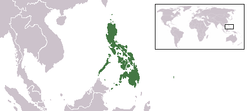Dictatorial Government of the Philippines | |||||||||||||
|---|---|---|---|---|---|---|---|---|---|---|---|---|---|
| 1898 | |||||||||||||
| Anthem: Marcha Nacional Filipina (English: "Philippine National March") | |||||||||||||
 Territory claimed by the Dictatorial Government of the Philippines in Asia | |||||||||||||
| Status | Unrecognized state | ||||||||||||
| Capital | Bacoor | ||||||||||||
| Common languages | Spanish, Tagalog | ||||||||||||
| Religion | Roman Catholicism, Islam, Philippine indigenous folk religions | ||||||||||||
| Government | Provisional authoritarian military dictatorship | ||||||||||||
| Emilio Aguinaldo | |||||||||||||
| Legislature | None (rule by decree) | ||||||||||||
| Historical era | Philippine Revolution | ||||||||||||
• Established | May 24, 1898 | ||||||||||||
| May 28, 1898 | |||||||||||||
| June 12, 1898 | |||||||||||||
• Proclamation (de jure) | June 18, 1898 | ||||||||||||
• Disestablished | June 23, 1898 | ||||||||||||
| Currency | Philippine Peso | ||||||||||||
| |||||||||||||
The Dictatorial Government of the Philippines (Spanish: Gobierno Dictatorial de Filipinas) was an insurgent government in the Spanish East Indies inaugurated during the Spanish–American War by Emilio Aguinaldo in a public address on May 24, 1898, on his return to the Philippines from exile in Hong Kong,[2] and formally established on June 18.[3][4] The government was officially a dictatorship with Aguinaldo formally holding the title of "Dictator".[1] The government was succeeded by a revolutionary government which was established by Aguinaldo on June 23.[5][6]
In 1896, the Philippine Revolution began. In December 1897, the Spanish government and the revolutionaries signed a truce, the Pact of Biak-na-Bato, requiring that the Spanish pay the revolutionaries 800,000 pesos and that Aguinaldo and other leaders go into exile in Hong Kong. In April 1898, at the outbreak of the Spanish–American War, Commodore George Dewey aboard the U.S.S. Olympia sailed from Hong Kong to Manila Bay leading the Asiatic Squadron of the U.S. Navy. On May 1, 1898, the United States defeated the Spanish in the Battle of Manila Bay. Emilio Aguinaldo decided to return to the Philippines to help American forces defeat the Spaniards. The U.S. Navy agreed to transport him back aboard the USS McCulloch, and on May 19, he arrived in Cavite.[7]
- ^ a b "The First Philippine Republic". National Historical Commission. September 7, 2012. Archived from the original on January 27, 2017. Retrieved May 26, 2018.
On June 20, Aguinaldo issued a decree organizing the judiciary, and on June 23, again upon Mabini's advice, major changes were promulgated and implemented: change of government from Dictatorial to Revolutionary; change of the Executive title from Dictator to President
- ^ Elliott 1917, pp. 490–491 (Appendix D: Aguinaldo's Proclamation on his Arrival at Cavite.)
- ^ Elliott 1917, pp. 491–493 (Appendix E: Aguinaldo's Proclamation of June 18, 1898, Establishing the Dictatorial Government)
- ^ Duka 2008, pp. 167–174
- ^ Kalaw 1927, pp. 423–429 (Appendix C.)
- ^ Guevara 1972, p. 35
- ^ Agoncillo 1990, p. 157.


